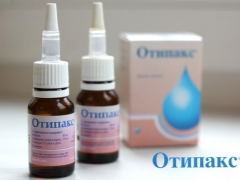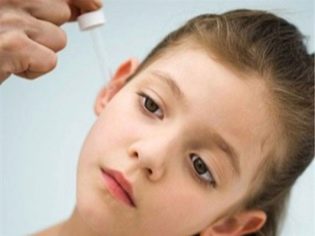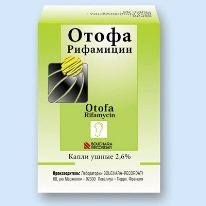Otipaks for children: instructions for use
If a child’s ear has inflamed, and this is manifested by severe pain, topical agents are often used. One of the most popular drugs for ear diseases is called Otipaks.
Adults often drip this medication for severe ear pain and other unpleasant otitis symptoms. But can it be used in children, how does this drug affect the sore ear and what dosage is used? How to bury the ears of small patients and what tools can replace Otipaks in the treatment of otitis of different nature?
Release form
Otipaks is produced by the French company Biocodex only in one form - ear drops. They are sold in glass bottles, supplemented with a dropper, which is separately packed in a blister. The weight of the drug in one bottle is 16 grams.
The medicine itself looks like a clear solution, which usually has no color, but sometimes has a yellow tint. Smell medication alcohol.
Composition
Otipaks action associated with the presence in the solution of two active substances at once. One of them is phenazone contained in 1 gram of the drug in a dose of 40 mg. The second active compound is lidocaine hydrochloride. Its amount per 1 g of solution is 10 mg.
To keep the product liquid and not spoiled, its auxiliary ingredients are ethyl alcohol, water, sodium thiosulfate and glycerol.
Operating principle
Otipaksa has an anti-inflammatory effect, which provides phenazone present in the drops. This component is one of nonsteroidal anti-inflammatory drugs (belongs to the group of pyrazolones) that can block cyclooxygenase and disrupt the synthesis of prostaglandins. It not only eliminates the inflammatory response, but also reduces capillary permeability.
Another important therapeutic effect of Otipaks is local anesthesia. Such action of drops is primarily due to lidocaine, because it is an effective anesthetic that acts through antagonism to calcium and sodium ions. This effect on the nerve fibers interferes with the perception and conduction of pain signals.
In addition, phenazone also has some analgesic effect, so the use of such ingredients in combination leads to more rapid elimination of pain, and the anesthetic effect is stronger and more durable.
This was confirmed by laboratory tests, according to which no traces of the drug were found in the blood of patients who had been buried in Otipax’s ear.
In this case, Otipaks acts only at the place of use, that is, such drops affect only the ear tissue. If the integrity of the tympanic septum is not broken, the drug is unable to be absorbed into the blood and have any harmful effects on the internal organs.
Indications
Otipaks is used as a symptomatic therapy (primarily with the purpose of pain relief) with such pathologies:
- Otitis media in the acute stage, characterized by acute catarrhal or purulent inflammatory process.
- Chronic otitis media.
- Otitis, which developed with SARS or influenza, as a complication of a viral infection.
- Otitis caused by ear barotrauma.
- External otitis.
Sometimes you can hear advice from moms or doctors to use Otipaks for prevention, for example, if your child has a bad cold and has a high risk of developing otitis.
Most prophylactic experts do not prescribe such drops, but pay attention to the correct treatment of rhinitis.
At what age is it allowed to take?
Otipaks is prescribed to children from birth, since this remedy is considered harmless to both newborn babies and older patients. In this case, the use of drops in a child with otitis is recommended only after examination by an ENT doctor or pediatrician.
It is impossible to drip even such a safe for children means into the ears without consulting a doctor, because for Otipax treatment it is important to first clarify if there is any damage to the eardrum. If its integrity is broken, it threatens with serious complications.
Contraindications
Drops are not prescribed in such cases:
- If the child has a damaged eardrum.
- If a small patient has a hypersensitivity to lidocaine or any other component of Otipax.
There are no other contraindications to treatment with drops, and they can be prescribed to adults both during pregnancy and during breastfeeding.
Side effects
When treating Otipax, allergic reactions may occur. In some patients, the contact of the drug with the ear canals provokes redness and irritation. If such negative symptoms or any other adverse reactions manifest themselves in a child, consultation with a doctor and replacement of drops with another medication is necessary.
Instructions for use
Often, the doctor prescribes to drip the drug in the ear twice a day, but sometimes it takes three times to apply. A single dosage for a child of any age - 3-4 drops. This amount of solution must be introduced into the external auditory meatus using a dropper attached to the bottle. To open the medicine, you need to remove the cap from the bottle, then remove the dropper from a separate package and, putting it on the bottle, screw tightly.
Further actions are as follows:
- Before you drop Otipax into the ear of your child, you need to hold the bottle with drops (if it was kept in the refrigerator) in a squeezed palm for a while to keep the solution warm a little. Contact of the cold medicament with the auricles is not allowed.
- To drip Otipaks, you need to turn the bottle and click on the center of the dropper. After the medication is introduced into the auricle, close the dropper tightly, tighten the white cap, and then remove the bottle away from the children.
- The head of the baby is turned so that the sore ear is located on top. Having instilled the drug, the child’s head should be held horizontally for some time to prevent the drops from flowing out. It is also possible to use cotton turunds to prevent medication leakage.
- If the drug is used with cotton wool flagella, the dose of medication prescribed by the doctor is dropped onto the end of the turunda and inserted into the ear canal.
- The duration of use should be determined by an ENT doctor, but usually the drug is not used for more than 10 days. If during this period the symptoms of the disease have not passed, a second examination by a specialist and another treatment is required.
You also need to show the child to the doctor, if on the second or third day of treatment with Otipaks no improvement is observed.
Overdose
Cases of negative effects of high doses of Otipaks have not yet been reported. If the patient's drum wall is intact, the medicine is not absorbed and does not harm the patient's body.
Interaction with other drugs
Otipaks does not mention the incompatibility of Otipaks with any other drugs, therefore the drug is often prescribed in combination with antibiotics, antiseptics and other means that help cure otitis media and affect the cause of the disease.
However, if doctors prescribe such drops along with other topical medications, they are not advised to bury various medicines in the ear with an interval of less than 30 minutes.
This means that other ear drops can be used no earlier than half an hour after applying Otipaks.
Terms of sale
Purchasing Otipaks at the pharmacy does not require a prescription, but consulting a doctor before using these drops is desirable. The average price of one bottle of drops is about 240-270 rubles.
Storage features
Otipaks sealed vial has a shelf life of 5 years; however, after the first use, the drops cannot be stored for longer than 6 months. If the drug was opened more than six months ago, it should be discarded.
You can keep the medicine at room temperature, but very often it is stored in the refrigerator.
It is important that the drug in such storage was inaccessible to kids.
Reviews
About the treatment of otitis in children Otipaks respond mostly well. According to the parents, the medication is very effective and helps to quickly get rid of pain, facilitating the child's condition.
As the moms say, the therapeutic effect of the drops begins to appear on average. 5-10 minutes after the injection of the solution in the ear. The drug is also praised for its use in infants, a short list of contraindications and ease of instillation.
ENT doctors also confirm the high efficacy of Otipaks. They prescribe this medication for an average of 3-7 days and say that such a short course is often enough to completely eliminate pain and reduce inflammation.
In addition, doctors confirm that the use of Otipaks in most cases helps to prevent the transition of otitis media to more severe purulent inflammation.
The tolerability of the drug, judging by the reviews, is good. Cases of allergies or local irritation are very rare. Some parents call the price of Otipaks acceptable, others - a little too high. Other deficiencies in the drug is not noted.
Analogs
If using Otipax in the treatment of ear pain and inflammation is for some reason impossible, the doctor will recommend a drop. Otyrelax. They contain the same active compounds, are written out with the same indications and are resolved at any age. In addition, this drug is cheaper.
In addition to Otirelax, for otitis, children can prescribe such drugs:
- Otofa. This local antibiotic is prescribed for otitis media and is used even with a torn eardrum. The doctor can prescribe it at any age.
- Otinum. This drug reduces pain and helps to combat inflammation due to the content of choline salicylate. It is used in children older than one year.
- Anauran. The effect of this drug is due to the combination of anesthetic and antibacterial substances. It can be dripped into the ears of children 1 year and older.
- Sofradex. Antibiotics are supplemented with glucocorticoid hormone in this otitis drug. The medicine is in demand in pediatrics, since it is allowed from 1 month.
- Polydex. Such a drug is also based on a combination of compounds with antibacterial action with a glucocorticoid. It is used in children of any age.
Since these and other ear drops are different from Otipaks and Otirelax by composition and contraindications, it is necessary to select an analogue for a child only with a doctor.
On how to properly bury the drops in the ears of a child, you can find out in the next video.


































